Related Research Articles

HMS Uganda was a Second World War-era Fiji-class light cruiser launched in 1941. She served in the Royal Navy during 1943 and 1944, including operations in the Mediterranean, and was transferred to the Royal Canadian Navy as HMCS Uganda in October 1944. She served in the Pacific theatre in 1945 and was put into reserve in 1947. When she was reactivated for the Korean War in 1952 she was renamed HMCS Quebec. She was decommissioned for the last time in 1956 and scrapped in Japan in 1961.
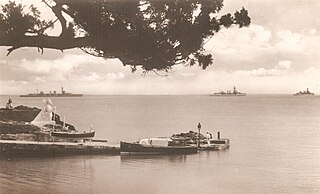
The North America and West Indies Station was a formation or command of the United Kingdom's Royal Navy stationed in North American waters from 1745 to 1956, with main bases at the Imperial fortresses of Bermuda and Halifax, Nova Scotia. The North American Station was separate from the Jamaica Station until 1830 when the two combined to form the North America and West Indies Station. It was briefly abolished in 1907 before being restored in 1915. It was renamed the America and West Indies Station in 1926. It was commanded by Commanders-in-Chief whose titles changed with the changing of the formation's name, eventually by the Commander-in-Chief, America and West Indies Station.

Royal Navy Dockyards were state-owned harbour facilities where ships of the Royal Navy were built, based, repaired and refitted. Until the mid-19th century the Royal Dockyards were the largest industrial complexes in Britain.

CCGS Labrador was a Wind-class icebreaker. First commissioned on 8 July 1954 as Her Majesty's Canadian Ship (HMCS) Labrador in the Royal Canadian Navy (RCN), Captain O.C.S. "Long Robbie" Robertson, GM, RCN, in command. She was transferred to the Department of Transport (DOT) on 22 November 1957, and re-designated Canadian Government Ship (CGS) Labrador. She was among the DOT fleet assigned to the nascent Canadian Coast Guard (CCG) when that organization was formed in 1962, and further re-designated Canadian Coast Guard Ship (CCGS) Labrador. Her career marked the beginning of the CCG's icebreaker operations which continue to this day. She extensively charted and documented the then-poorly-known Canadian Arctic, and as HMCS Labrador was the first ship to circumnavigate North America in a single voyage. The ship was taken out of service in 1987 and broken up for scrap in 1989.

Starting with the 1763 Treaty of Paris, New France, of which the colony of Canada was a part, formally became a part of the British Empire. The Royal Proclamation of 1763 enlarged the colony of Canada under the name of the Province of Quebec, which with the Constitutional Act 1791 became known as the Canadas. With the Act of Union 1840, Upper and Lower Canada were joined to become the United Province of Canada.

CGS Canada was a patrol vessel, sometimes referred to as a cruiser, in the Fisheries Protection Service of Canada, an enforcement agency that was part of the Department of Marine and Fisheries. Canada is considered to be the nucleus of the Royal Canadian Navy for her role in training Canadian naval officers and asserting Canadian sovereignty. Canada saw service in the First World War and was commissioned into the Royal Canadian Navy as HMCS Canada during that conflict. Following the war, the vessel was sold for commercial use and renamed MV Queen of Nassau. On the verge of being sold again, the ship sank in Straits of Florida on 2 July 1926.
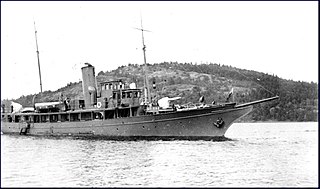
HMCS Florence was a commissioned patrol vessel of the Royal Canadian Navy that served in the First World War. Originally launched as the yacht Czarina, she was acquired by John Craig Eaton in 1910 and renamed Florence. Following the outbreak of war, Eaton donated the yacht to the Royal Canadian Navy. The ship had a short career and proved unsuitable for navy work and was paid off in September 1916. The vessel was subsequently sold to buyers in Martinique, and was reportedly lost in the Caribbean Sea in January 1917.
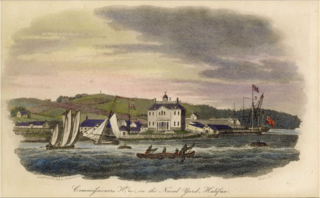
Royal Naval Dockyard, Halifax was a Royal Navy base in Halifax, Nova Scotia. Established in 1759, the Halifax Yard served as the headquarters for the Royal Navy's North American Station for sixty years, starting with the Seven Years' War. The Royal Navy continued to operate the station until it was closed in 1905. The station was sold to Canada in 1907 becoming His Majesty's Canadian Dockyard, a function it still serves today as part of CFB Halifax.

The Kingston Royal Naval Dockyard was a Royal Navy Dockyard from 1788 to 1853 in Kingston, Ontario, Canada, at the site of the current Royal Military College of Canada.

Amherstburg Royal Naval Dockyard was a Provincial Marine and then a Royal Navy yard from 1796 to 1813 in Amherstburg, Ontario, situated on the Detroit River. The yard comprised blockhouses, storehouses, magazine, wood yard and wharf. The yard was established in 1796 to support the Upper Canada Provincial Marine after Great Britain ceded a pre-existing shipyard on the Detroit River to the United States. Amherstburg Royal Naval Dockyard constructed four warships for the Lake Erie detachment of the Provincial Marine before and during the War of 1812. In 1813 the dockyard was abandoned and destroyed when the British retreated and never reopened. In 1928, the site was designated a National Historic Site of Canada.
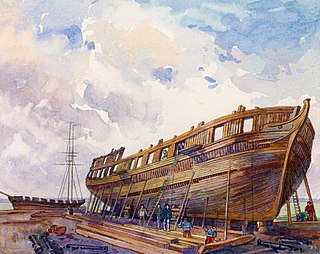
The Naval Shipyards were naval shipbuilding facilities used by the Provincial Marine and the Royal Navy in York, Upper Canada. The naval shipyards were ordered by the Lieutenant Governor of Upper Canada John Graves Simcoe in 1793, and were opened in 1798.

Provincial Marine was a coastal protection service in charge of the waters in the Great Lakes, the St. Lawrence River and parts of Lake Champlain under British control. While ships of the Provincial Marine were designated HMS, they were operated in more of a coast guard manner than as a full-fledged navy. Most ships of the Provincial Marine were built on the Great Lakes.
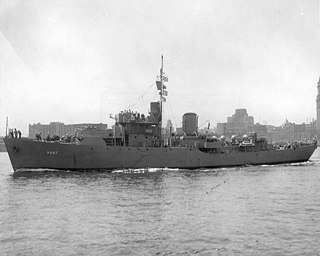
USS Alacrity (PG-87) was an Action-class patrol boat acquired by the United States Navy for the task of patrolling American coastal waters during World War II.

USS Galena was a wooden armed steamer in commission in the United States Navy from 1880 to 1890. She had an active career in which she operated in the North Atlantic Squadron and South Atlantic Squadron, seeing duty in the Mediterranean Sea and Aegean Sea, along the east coast of South America, in the Caribbean, in the waters of Canada, and along the United States East Coast and United States Gulf Coast.

Henry Eckford was a Scottish-born American shipbuilder, naval architect, industrial engineer, and entrepreneur who worked for the United States Navy and the navy of the Ottoman Empire in the early 19th century. After building a national reputation in the United States through his shipbuilding successes during the War of 1812, he became a prominent business and political figure in New York City in the 1810s, 1820s, and early 1830s.
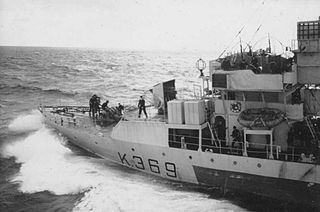
HMCS West York was a Flower-class corvette of the Royal Canadian Navy which took part in convoy escort duties during the Second World War. Named after Weston, Ontario, she was built by Midland Shipyards Ltd. in Midland, Ontario and commissioned on 6 October 1944 at Collingwood.

HMCS Raccoon was an armed yacht that served in the Royal Canadian Navy during World War II. Purchased by the Royal Canadian Navy in 1940, the ship was originally known as the yacht Halonia. Used as a patrol vessel and convoy escort, the ship was sunk by the German submarine U-165 in the St. Lawrence River on 7 September 1942. Raccoon was escorting Convoy QS-33 at the time. The entire ship's crew was lost.
HMS Flax, a modified Flower-class corvette, was laid down on 28 February 1942 at Kingston, Ontario, Canada, by War Supplies Ltd., for the Royal Navy. Launched on 15 June 1942 it was reallocated to the United States under the so-called "Reverse Lend-Lease" program and renamed and redesignated Brisk (PG-89) on 14 August 1942. Completed on 5 December 1942, the ship was commissioned on 6 December 1942.

HMCS Galt was a Flower-class corvette of the Royal Canadian Navy that served during the Second World War. She saw action primarily in the Battle of the Atlantic. She was named after the city of Galt, Ontario.
HMCS Reindeer was an armed yacht that served in the Royal Canadian Navy during the Second World War. She served mainly in local waters, escorting convoys until becoming a training ship at Halifax, Nova Scotia at the end of 1942. The ship remained as such until being paid off to reserve in 1945 and was sold. Constructed as Josephine in 1926 in the United States and renamed Mascotte, the yacht was acquired by the Royal Canadian Navy in 1940. Following the war, the vessel was sold.
